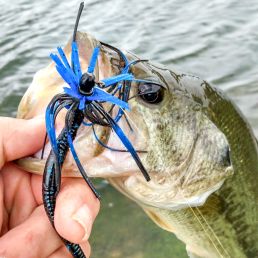Catch More Bass with this Proven Method
SHARE THIS POST
For many years, I’ve been using a method of bottom-crawling Texas-rigged, soft plastic lures which I call “sliding.” Although there may be some similarities, this should not be confused with the old Charlie Brewer Slider.
The technique is extremely easy but demands concentration on what the line and lure are doing. It also requires the ability to detect strikes by feeling a pulling force on the rod.
Primarily, the idea is to keep the lure in contact with the bottom. Don’t hop or lift the lure.
After the lure hits the bottom, keep the rod tip parallel to the water’s surface. Slowly pull the rod sideways, from 1 to 3 feet. Pause and reel up the slack, keeping a taut line. Repeat the steps until the line is completely retrieved. Don’t lift the rod tip unless there is a hang-up, and then only enough to bring it over the piece of structure or pop it loose from a weed. Many times, the strike will come after the lure has dropped over the obstacle or as it pops loose.
Another method of retrieve is to constantly turn the reel handle at a very slow pace. Again, be sure to stay in contact with the bottom.
With either retrieve, the strike will appear as line movement to the side, a slight twitch or tap, and/or a gradual, soft pull. This pull feels similar to placing a rod tip under a tree limb and picking upward. There will be a bit of a “give,” but the pressure is still present.
Very seldom will the strike come as a bone-jarring hit, such as is experienced with some faster-moving lures. One reason for this is that it is mainly used to appeal to less-active fish.
Are you enjoying this post?
You can be among the first to get the latest info on where to go, what to use and how to use it!
I’ve used this procedure with every style of rod and reel combination, from ultra-light spinning to an 8.5-foot, medium-heavy steelhead action casting rig. Anyone can do it, and it catches fish.
While any soft plastic lures will work, my favorites have been a 4-inch, thick-walled tube (Such as a model produced by QC Lure Worx), a 4-inch finesse worm (Natural Forage Baits R4), 7-inch ribbon tailed worm (Natural Forage Baits R7), 5-inch FattyZ and smaller TRD FattyZ, and a 4-inch craw worm (Natural Forage Baits Mad Craw). Not only will I fish these lures with the “sliding” method via a Texas rig, but also rigged with a B-Fish-N H2O Precision lead head jig when an open hook is needed and can be used in deep water with fewer snags.
If so desired, other lures, such as a skirted jig combination with a Blitz Finesse jig with 4-inch worm or Spyder Jig with Mad Craw, and a ProX hook Texas rigged minnow body like the NFB FT Shad and B-Fish-N Ribb Finn, with and without weight, can be used with the sliding technique.
The Carolina rig is similar to this method. However, “sliding” with a Texas rig or jig head provides more direct contact and feel with the lure. As a result, easier strike detection and hook setting is accomplished.
This technique has been one of my favorites and is great for teaching people to detect strikes with soft plastic lures. It has proven very effective for bass of all sizes, but definitely for larger bass when they are in a negative mood and close to the bottom.
For helpful bass fishing insight, check out the articles in every issue of MidWest Outdoors. Subscribe on our website.
MWO
SHARE THIS POST
You may also like...
Nothing found.
Did you enjoy this post?
You can be among the first to get the latest info on where to go, what to use and how to use it!
Dan Galusha
Dan Galusha has fished all of his life, worked more than 45 years in the outdoor/media industry, and was inducted into the Fresh Water Fishing Hall of Fame as a Legendary Communicator. Direct questions through dansfishntales.com, facebook.com/dansfishntales and facebook.com/shootnplink.
